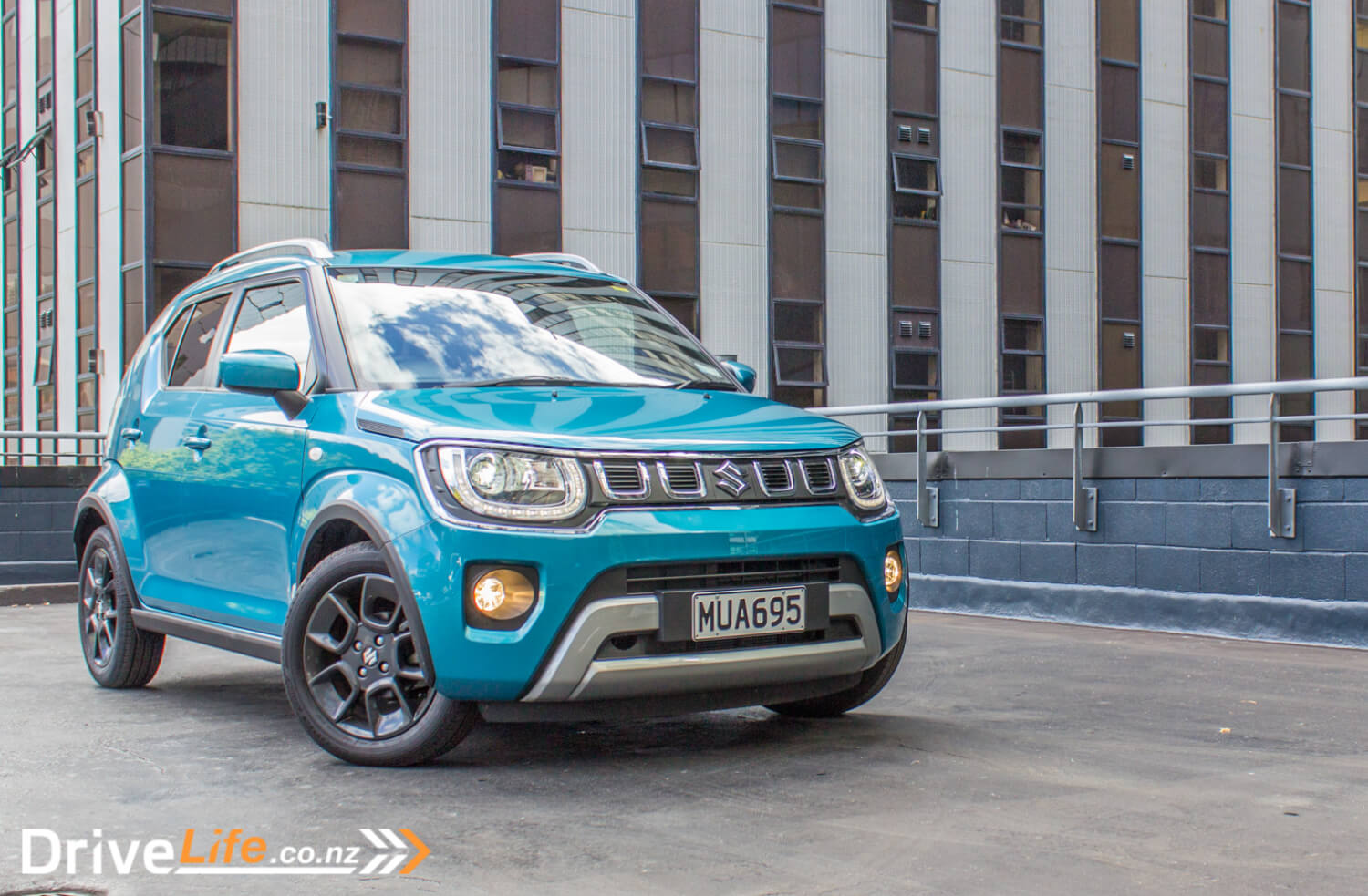We last reviewed the tiny Suzuki Ignis when it was first launched back in 2017. Rob Clubley did the review, and found it funky but a little flawed.
For 2021, Suzuki have given the car a bit of a facelift, added roof rails as standard, and made some other minor exterior tweaks including restyled bumpers, and new inlays on the body – all designed, Suzuki says, to give the Ignis an even more rugged look.
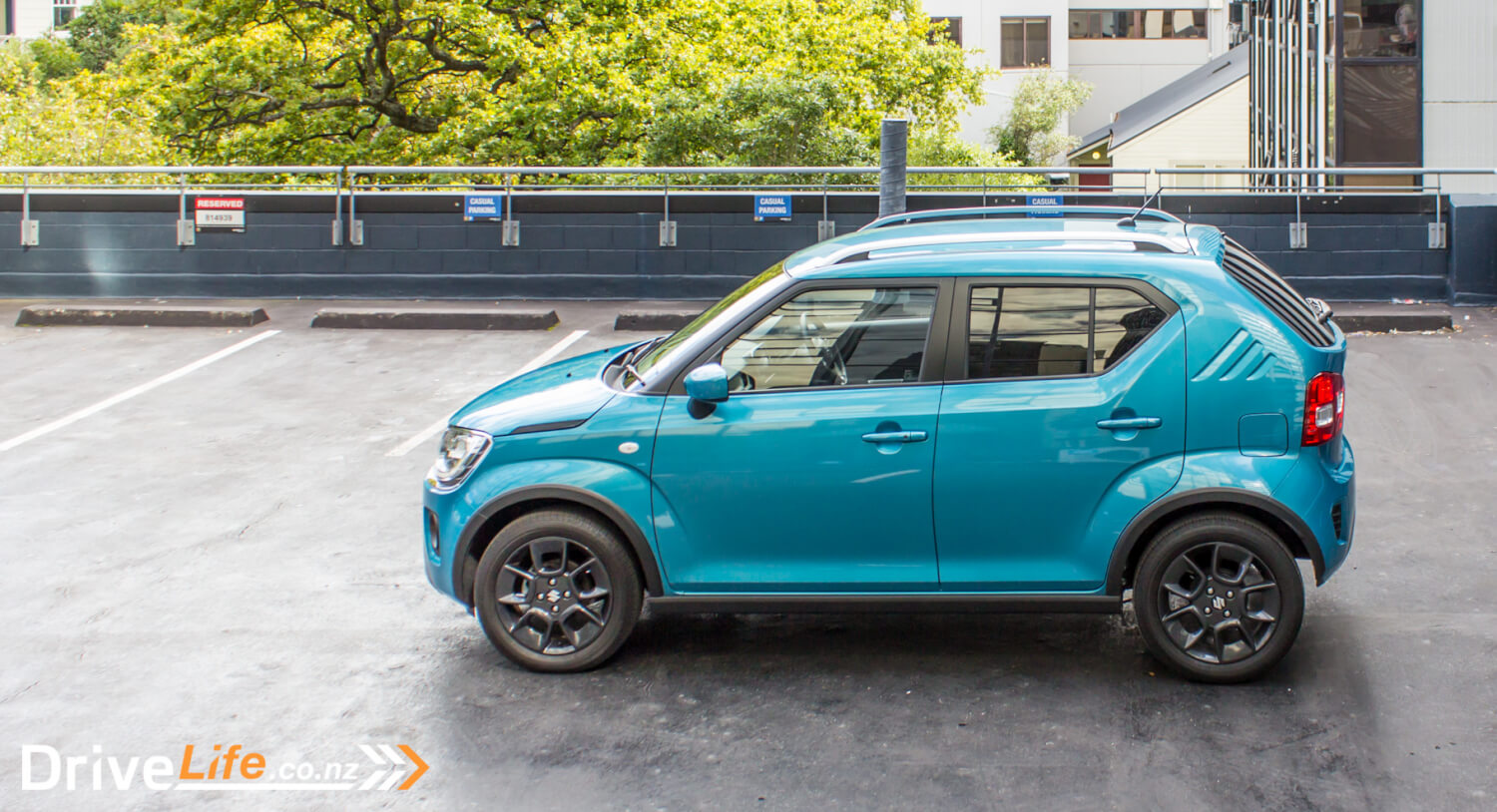
Interior changes include revised trim detailing, new seat upholstery, and driver’s seat height adjustment among other things.
With a five-year warranty and five years of Roadside Assistance, could the latest Ignis be the answer to those wanting a very small city car with funky styling? We spent a week with a top-spec LTD model to see if the 2021 Ignis is as good as it looks, and has improved from 2017.
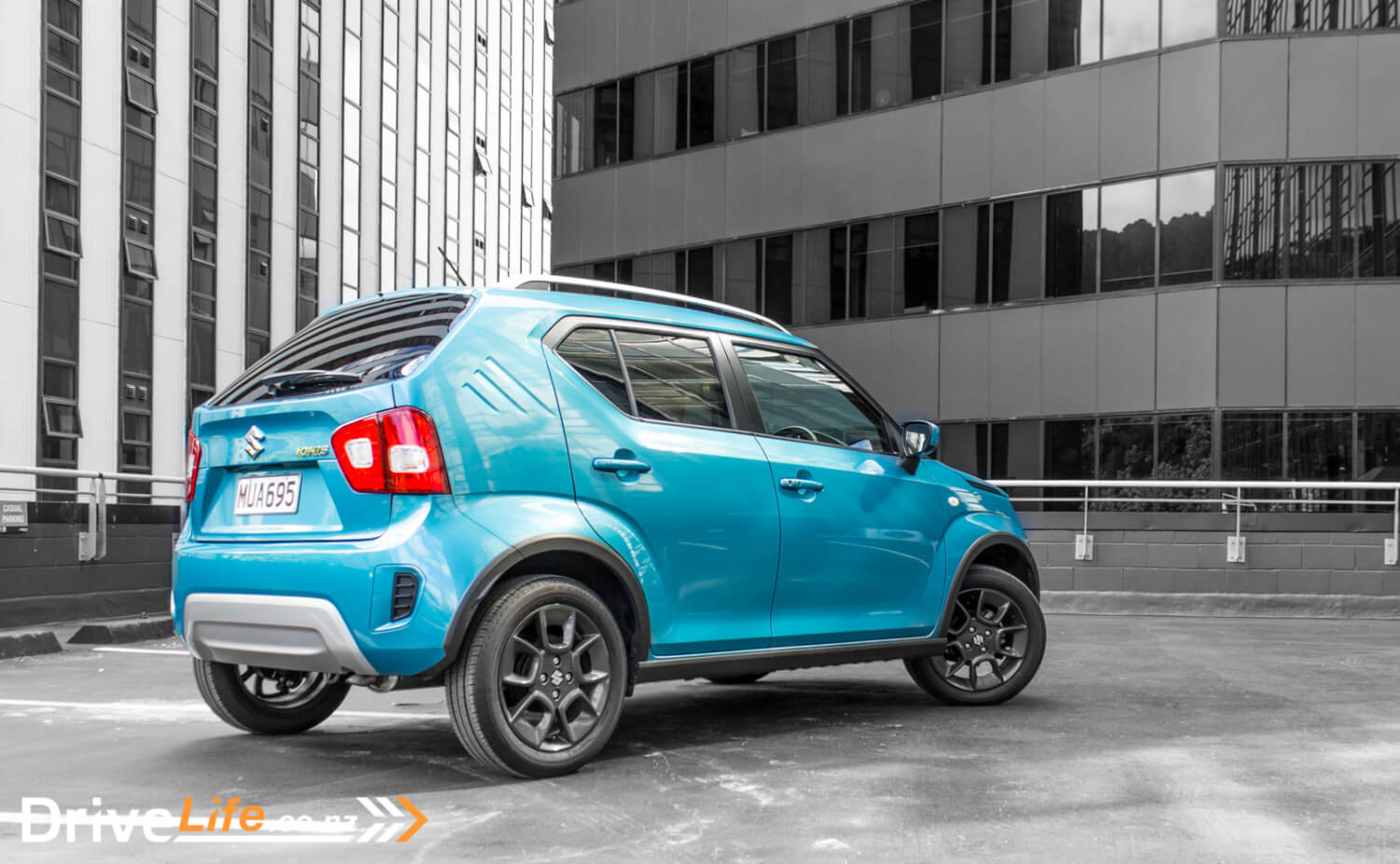
What’s In The 2021 Suzuki Ignis Range?
Buying an Ignis starts off with the GLX base model, with – yes, it’s true – a 5-speed manual transmission. Priced at a strategic $19,990, this model has the same 1.2-litre, four-cylinder petrol engine as the other higher-spec models (and it’s the same engine and transmission as the base Swift). The engine manages 66kW of power and 120Nm of torque and Suzuki says it will use 4.8L of petrol per 100Km driven.

The manual model is definitely a cut-down version on the features front, for your $19,990. As standard, there’s a 4-speaker audio system with Bluetooth, air con, a leather covered steering wheel, cruise control and speed limiter, a tilt/adjustable steering wheel, driver’s seat height adjustment, 7 drink holders, a luggage area cover, 15” steel wheels, halogen headlamps, and front fog lamps.
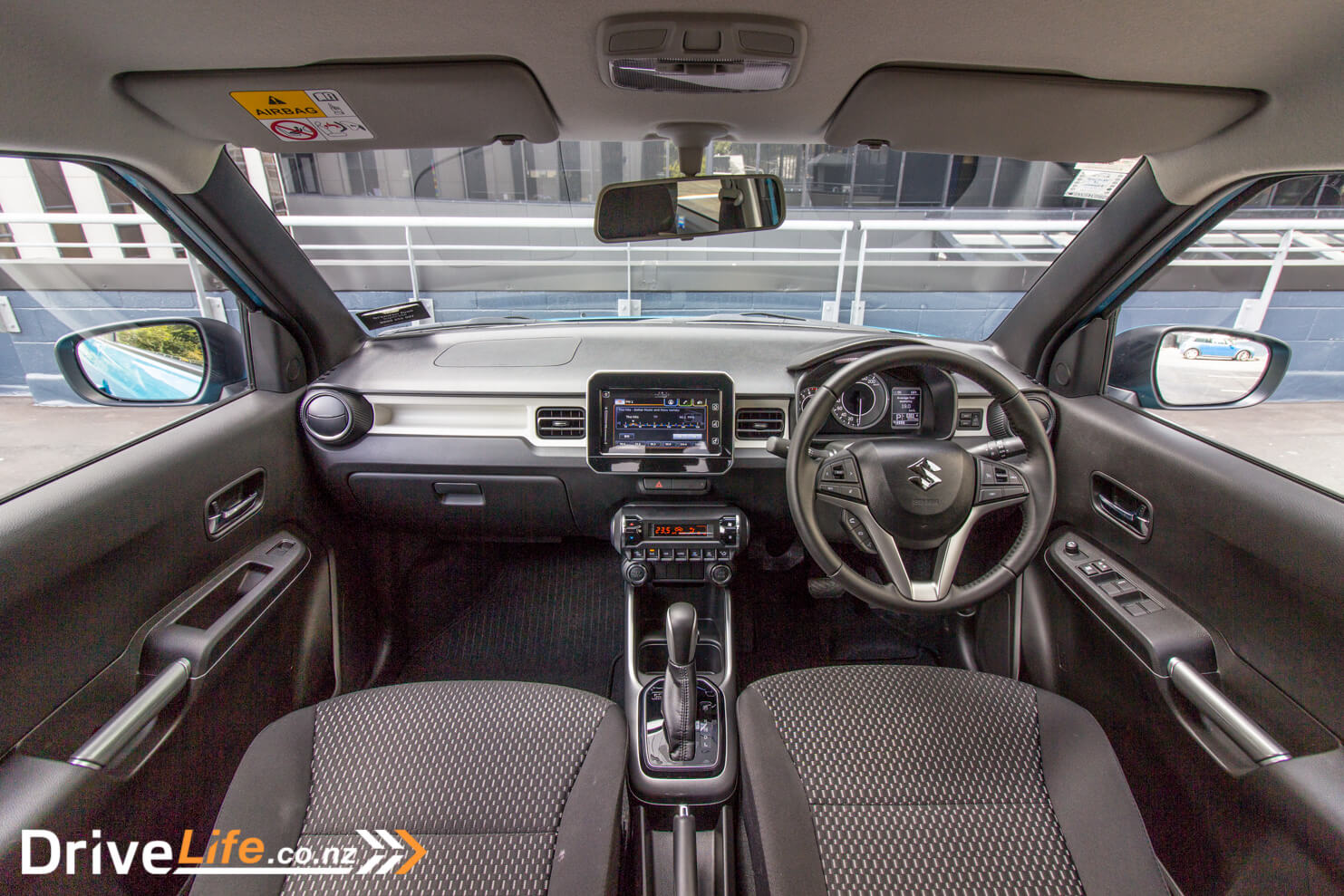
By going to the next model up, the $22,990 CVT automatic GLX base version, you will then get a 7” touchscreen, SatNav, Apple CarPlay and Android Auto, a reversing camera and hill start assist. I can’t work out why the manual gearbox model wouldn’t have hill start assist, but there you go.
Moving to the top-spec $ 24,990 LTD model, audio moves to 6 speakers, there’s also climate controlled air con, keyless entry and start, 16” alloy wheels, LED projector headlamps, privacy glass, automatic self-levelling headlights, LED DRLs, Guide Me lighting, and height adjustable seat belts.

There’s a reasonable range of six colours; White Pearl, Neon Blue, Flame Orange, Rush Yellow, Fervent Red, and Caravan Ivory Pearl. Thank you Suzuki NZ for not offering grey or silver – the Ignis deserves to be in a bright colour.
You can read more about the Ignis on Suzuki New Zealand’s website.
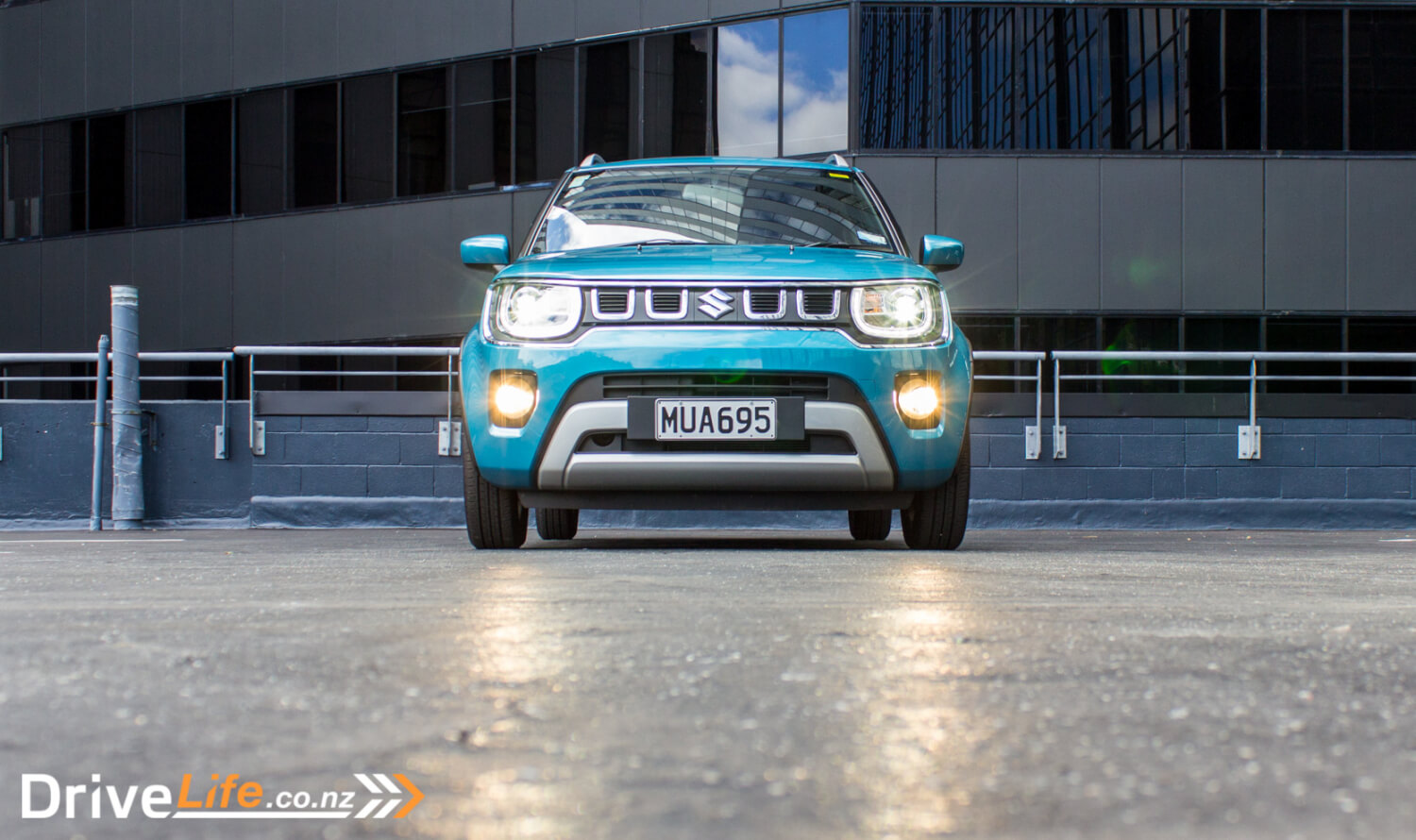
First Impressions Of The 2021 Suzuki Ignis LTD
“The updates improve the visual appeal and styling for a car that looks like nothing else,” said Gary Collins, General Manager of Marketing for Suzuki New Zealand. “As New Zealand’s only super compact SUV, the Ignis is truly unique with its stand-out styling.”
Well, I couldn’t argue with that comment, except perhaps the Ignis being an SUV? It’s true that the Ignis has always stood out on the road, and certainly looks like the spunky city car it’s designed to be. Our test car was finished in Neon Blue, and it looked excellent. Day by day, the shape and colour grew on me and I liked it more every time I drove the car. But a compact SUV? Yeah, nah. If you go to Suzuki New Zealand’s website, you won’t find the Ignis under Small Cars, instead you have to go to SUVs. So they are committed to the cause here, at least.
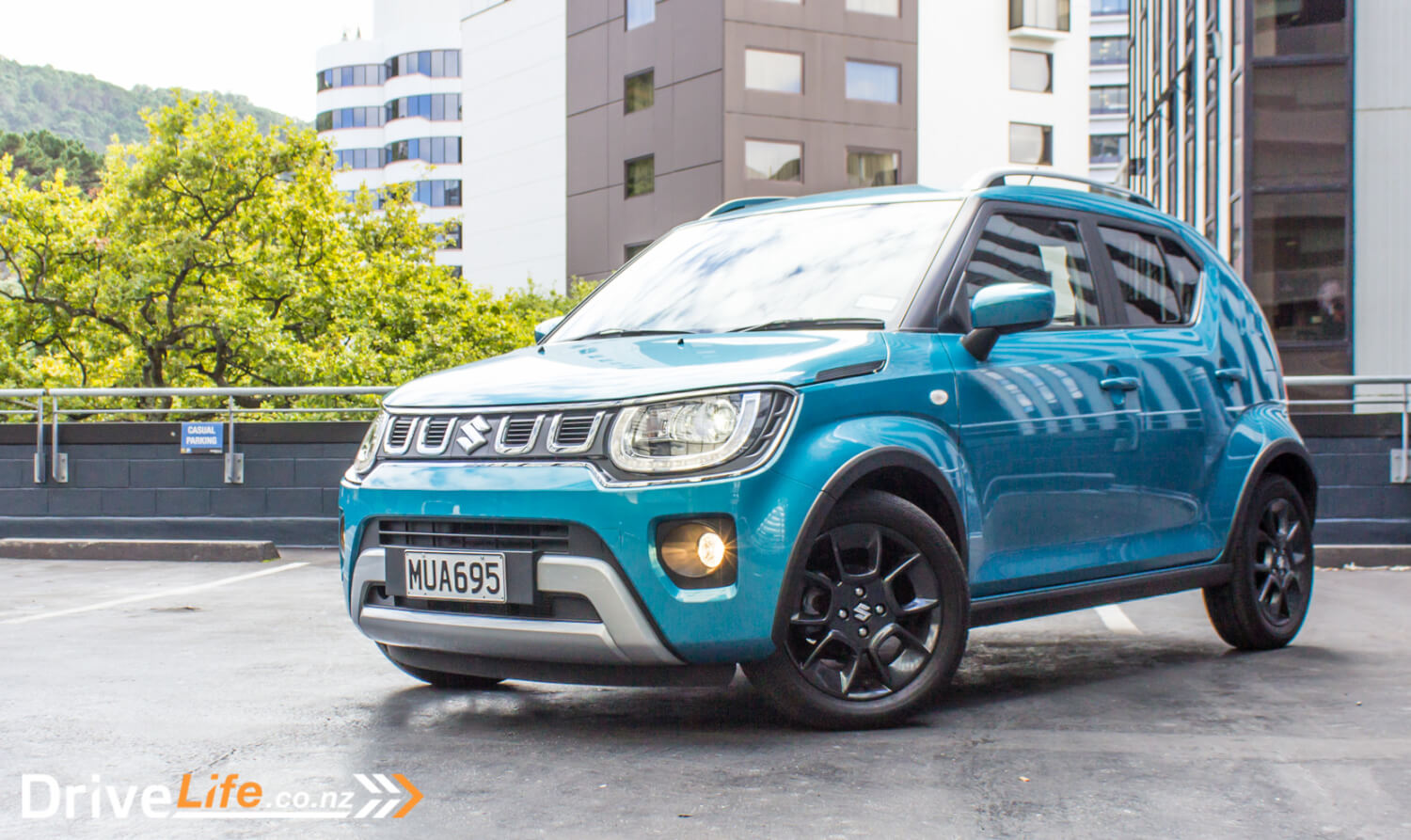
The changes for this year aren’t massive, but it does freshen the look to bring it closer to current design trends, while still maintaining its individuality. Many people I spoke to loved the look of the new Ignis, and this is likely one of its strongest selling points.
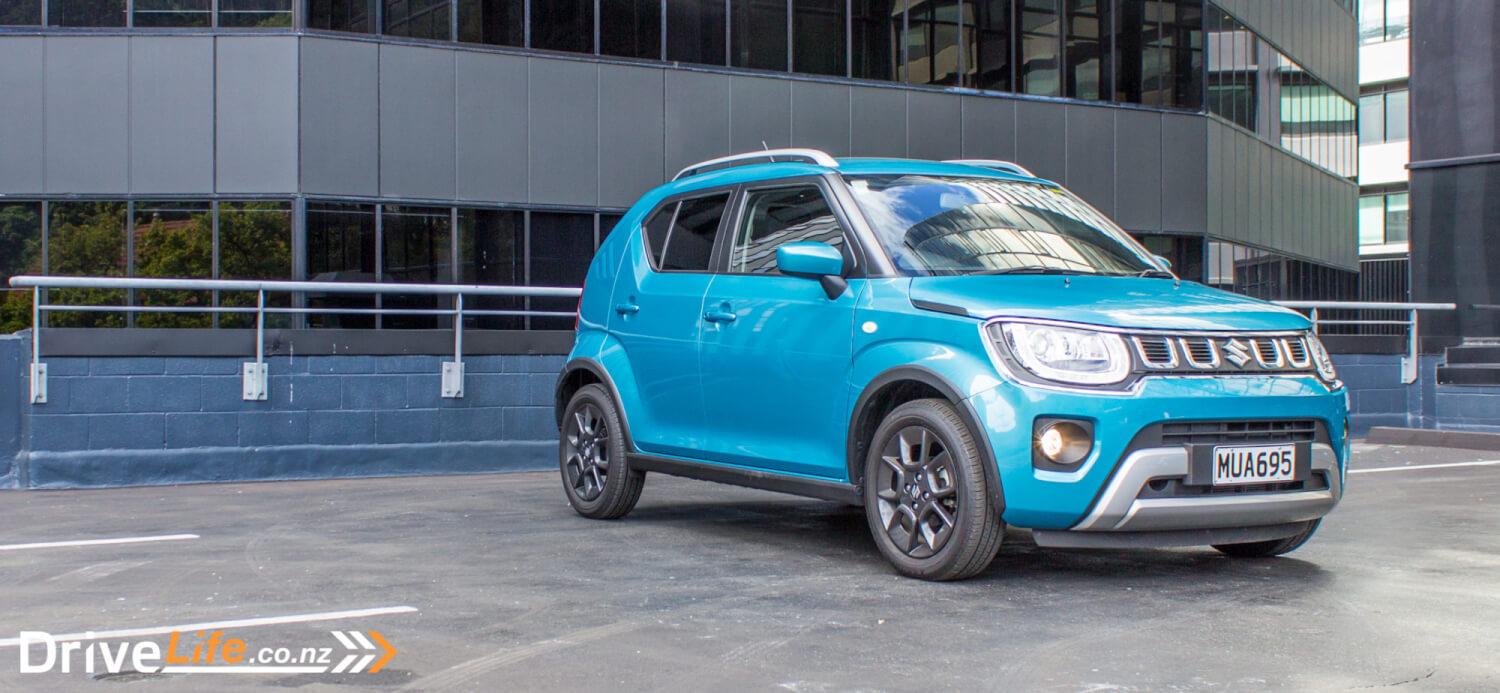
What’s The Interior Like On A 2021 Suzuki Ignis LTD?
With a beige headlining and plenty of headroom, the Ignis’ interior comes across as spacious, light, and airy. Sure, it’s not a long car, but the car’s space belies its exterior dimensions.
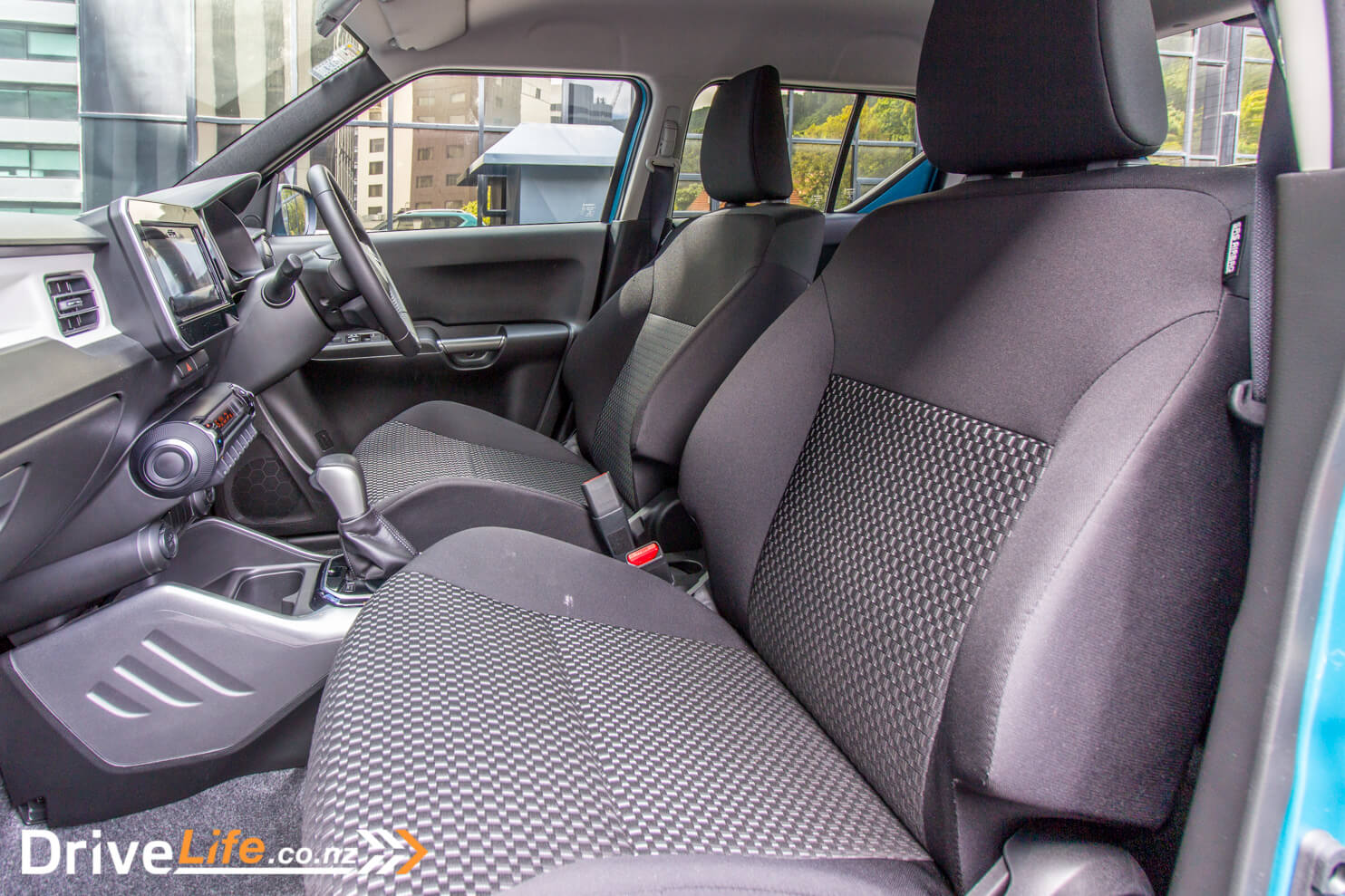
Rear legroom is bordering on incredible, and with its upright stance there’s plenty of room for four. Why not five? The LTD Ignis is a four-seater, so keep that in mind if carrying five people around is one of your requirements. Don’t ask me why, but if you want a 5-seat Ignis, you need to buy one of the GLX models.
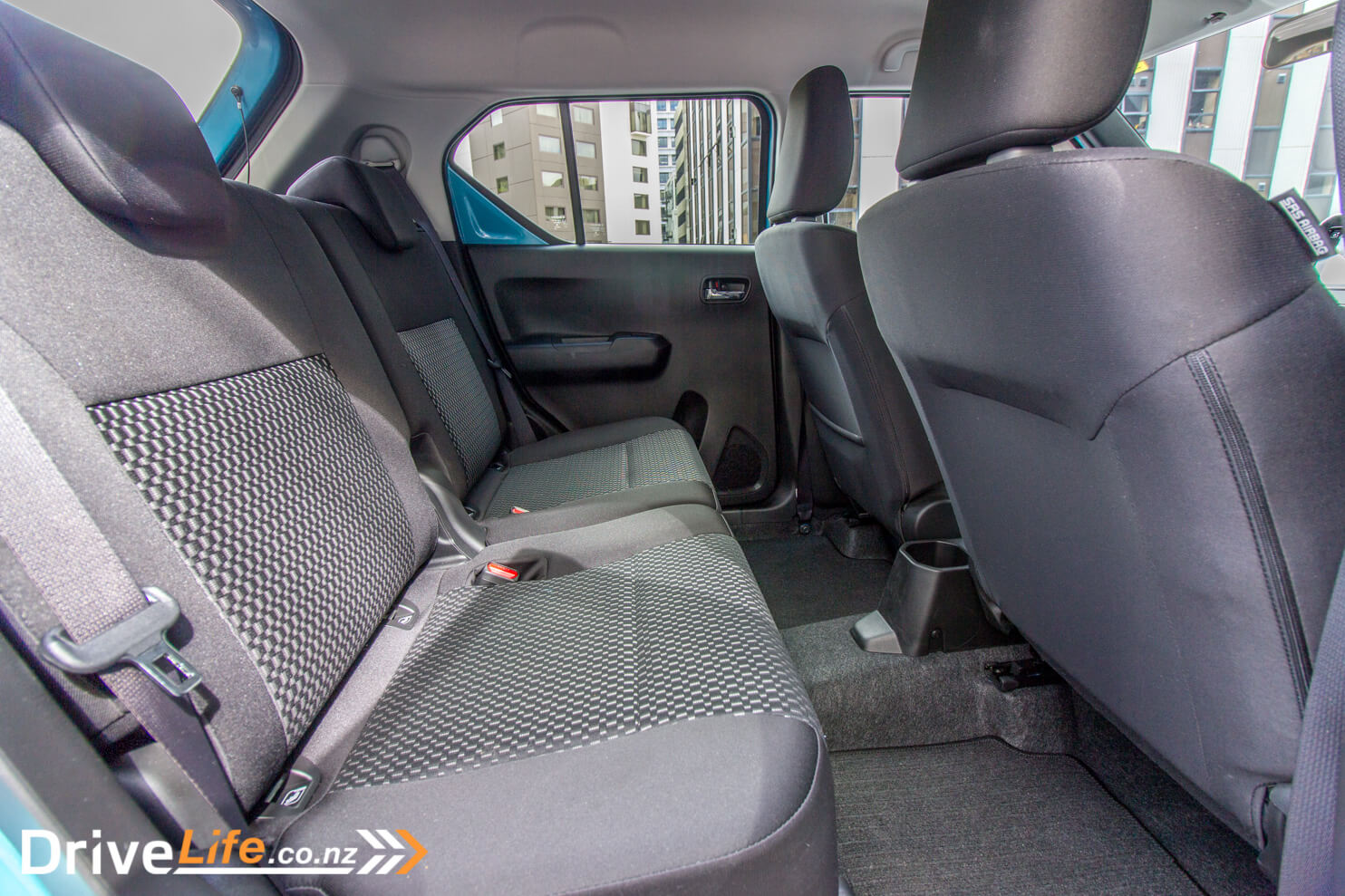
Front seat passengers have access to a single USB port, an AUX port for sounds and also a 12-volt power socket.
The glovebox too is spacious, and is a double-layer affair so there’s plenty of room in there for all your stuff you never use but insist on carrying around. Understandably, the car does feel a bit plastickly inside, but everything looks and feels well made. The dash has splashes of white plastic in just the right amount; it makes the car feel a little funky without going overboard into love it/hate it territory.
Rear seats are 50/50 split folding in the LTD, and 60/40 in the GLX, and a nice touch is that they’re sliding as well (LTD only model), so you can use up some of that excess rear legroom to give yourself more boot space.
Speaking of the rear, the rear doors open almost perpendicular to the car, allowing excellent access. This is in sharp comparison to the Toyota Yaris, whose rear doors don’t open wide at all. The front doors in the Ignis are good too, opening out wide.
The boot is fairly deep, and you will find a space-saver spare under the false floor. Eyes looking into the boot from the outside are blocked by a fairly flimsy parcel tray. It’s thin and wobbly, but it does its job. At 264 litres, the boot is good in size too (and that’s more than a Corolla hatch), and with the rear seats folded down, it grows to 516 litres – and that’s before sliding the seats forward. It is the depth that gets you though, and I dare say a certain group of buyers will be able to fit tall plants from the local nursery comfortably in there.
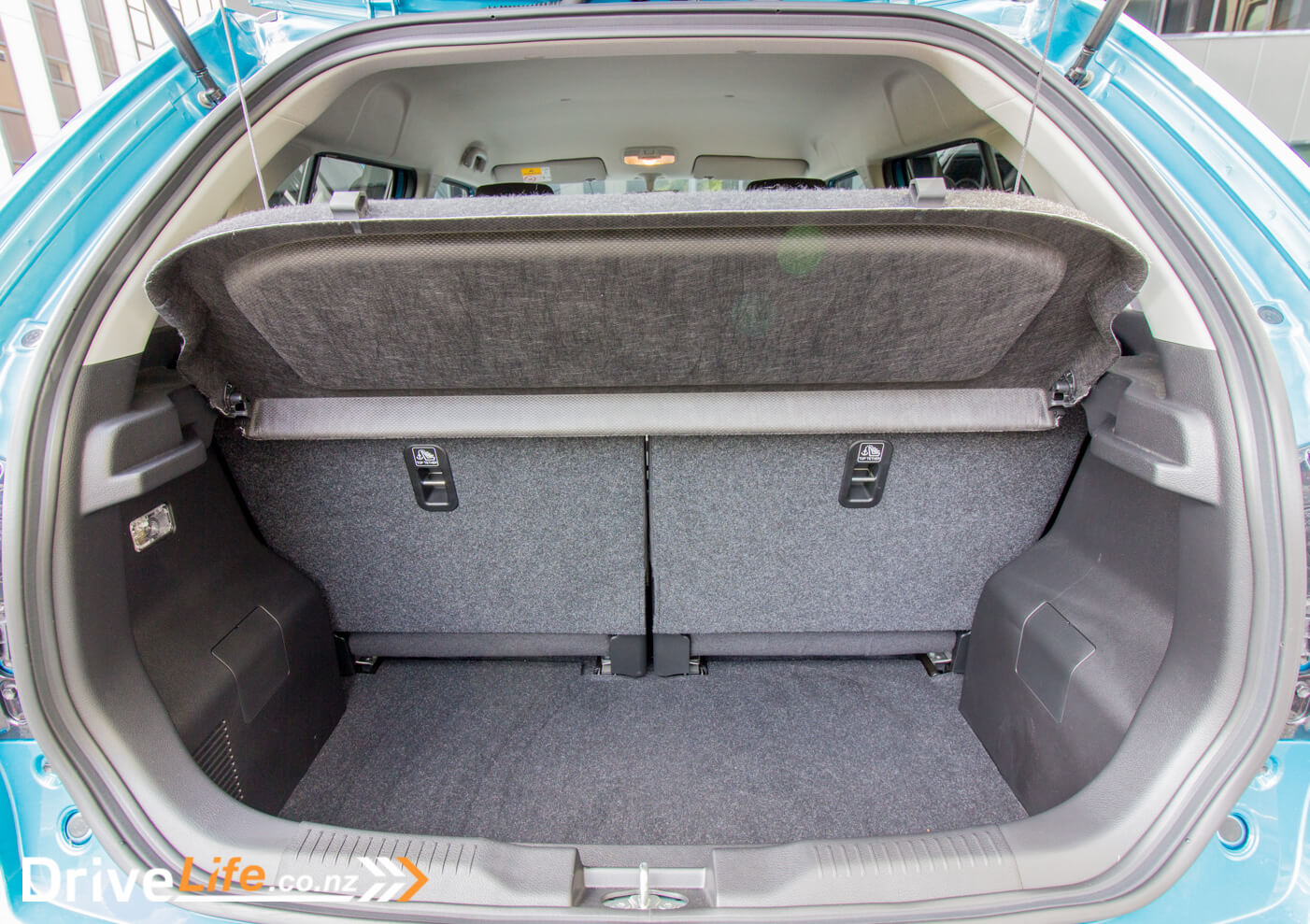
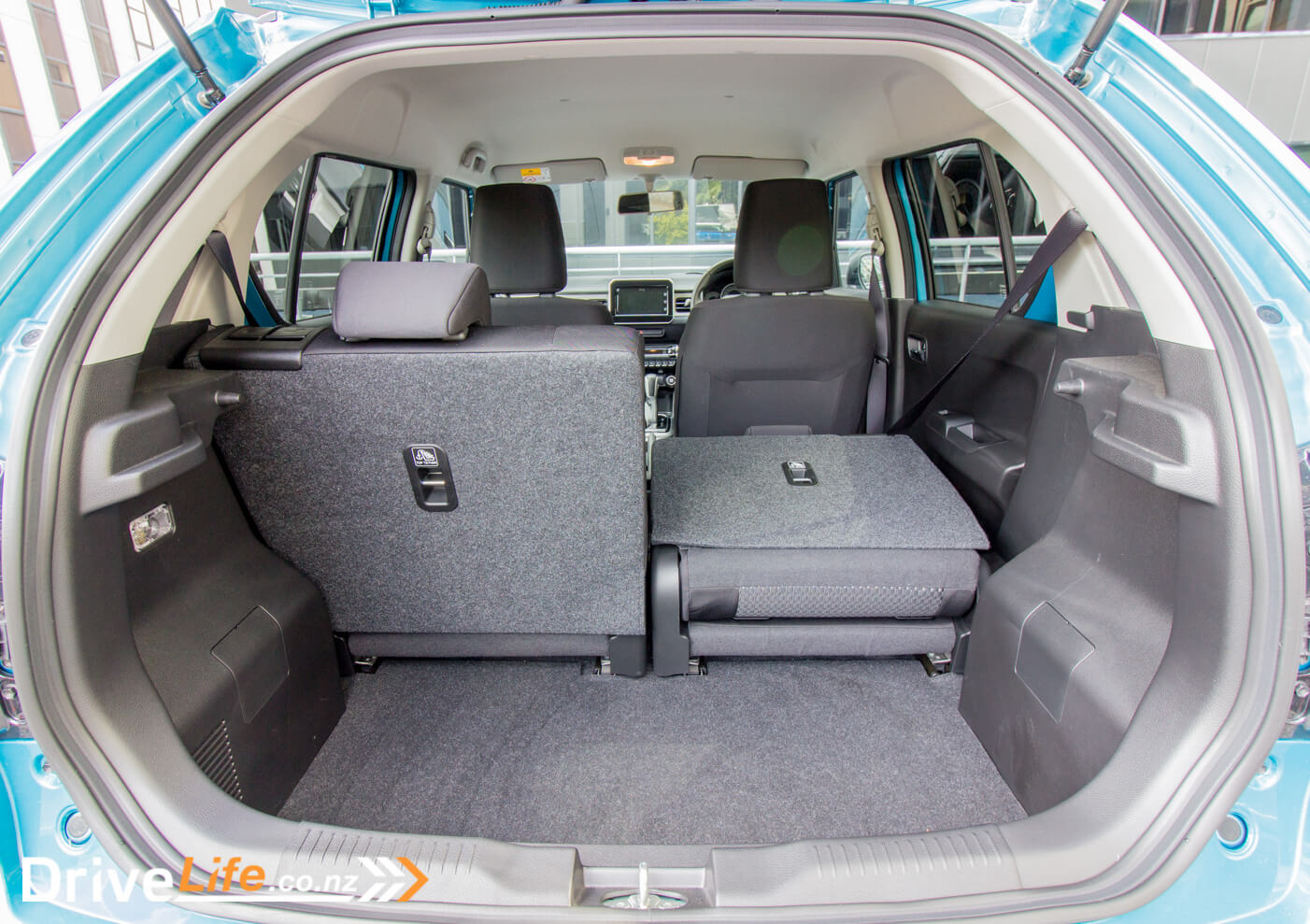
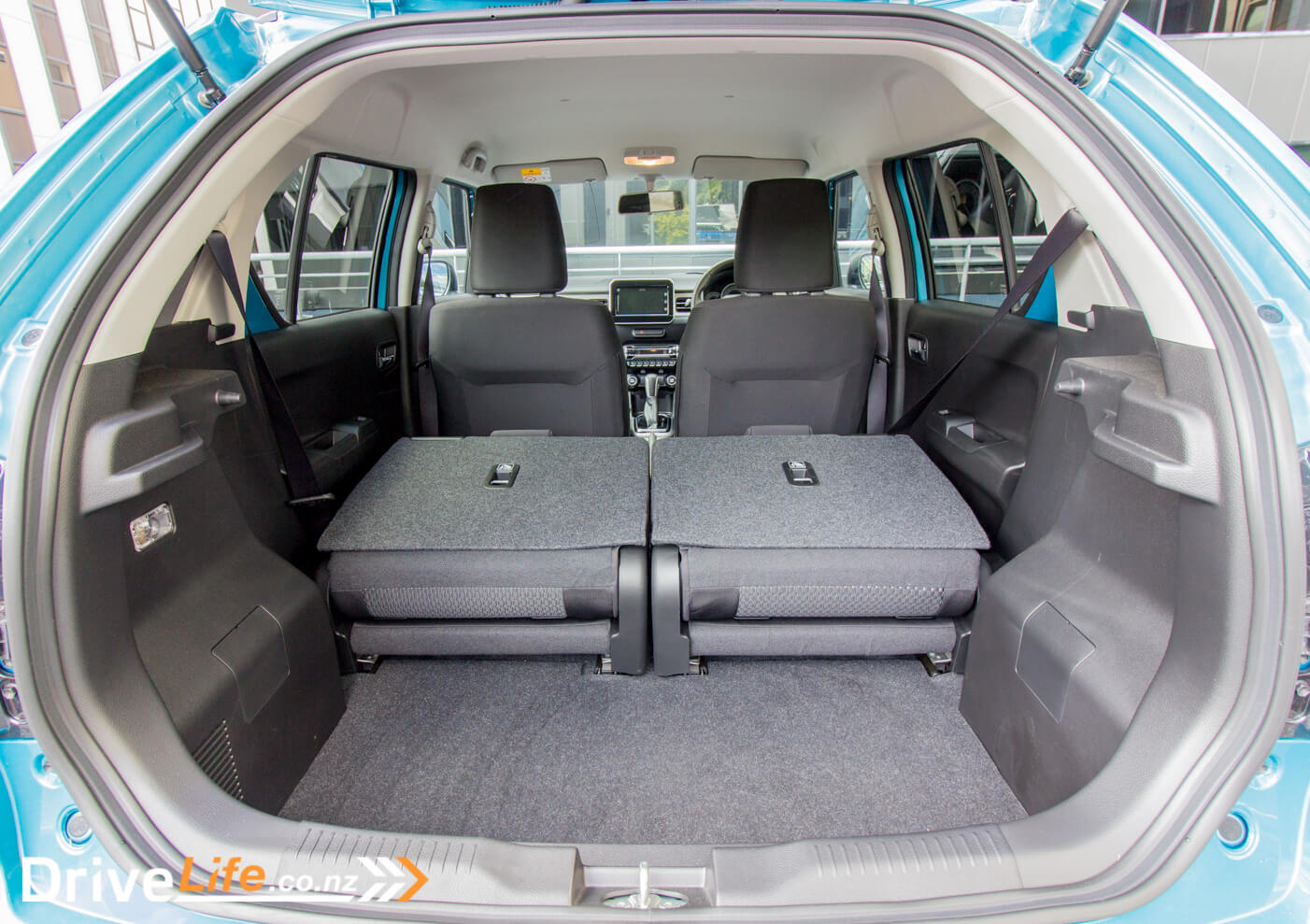

What Does The 2021 Suzuki Ignis LTD Drive Like?
First things first; connect my phone via Bluetooth. This takes less than 30 seconds, so I’m off to a good start. Driving off, the 1.2-litre engine feels peppy enough, although its performance is dulled by the CVT transmission. It’s not a bad CVT, but oh how I wish I had got the manual Ignis instead. That was the Ignis I’d love to drive.
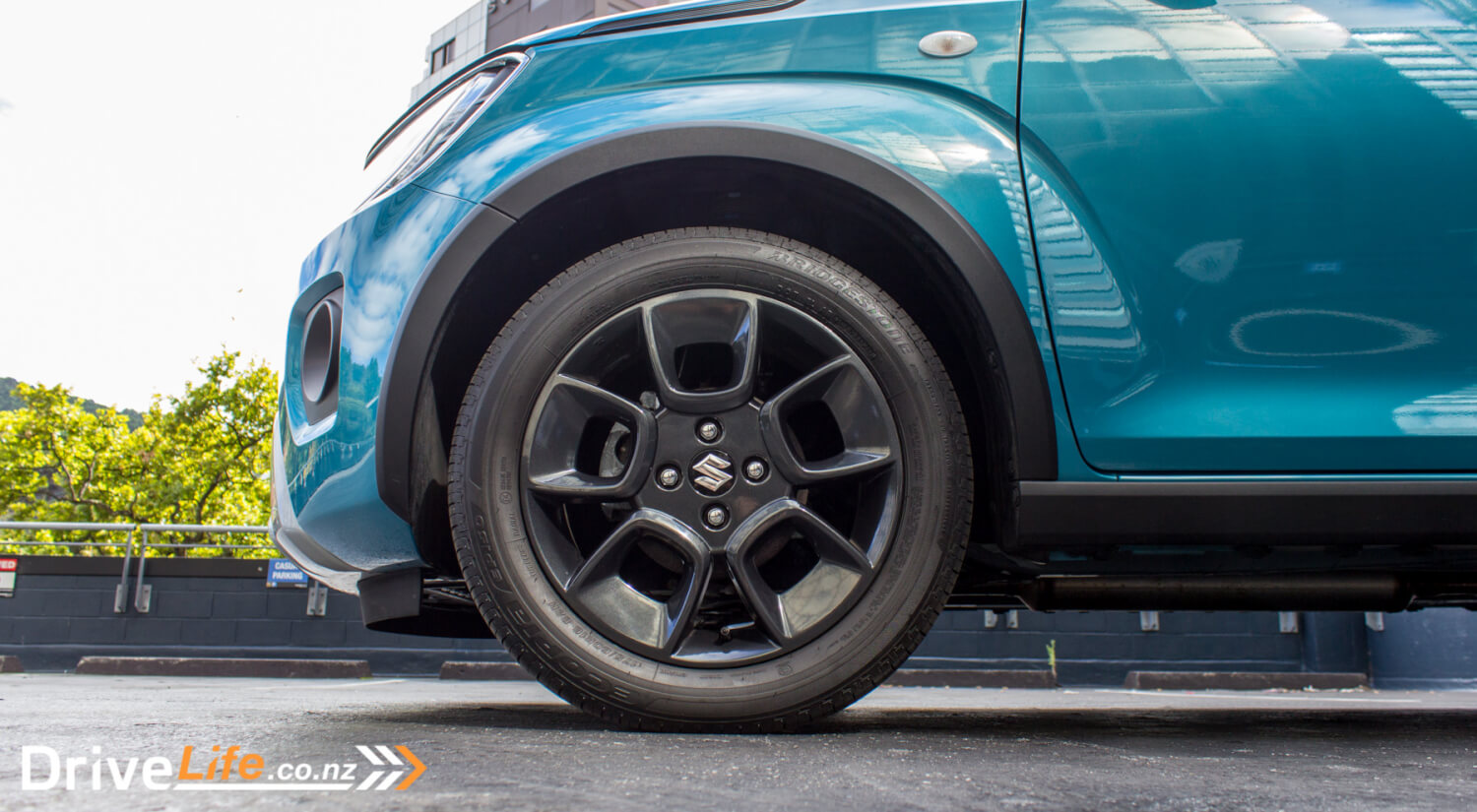
As mentioned, the CVT isn’t bad at all, and it’s suited to target buyers who might be elderely; pottering around the suburbs, the CVT does its job well. But it’s a different story if you floor it – you’ll get quite a bit of CVT Flaring. In saying that, performance from that little engine is acceptable. Again, just tootling about there’s no issues at all, and it can feel like a peppy little power unit.
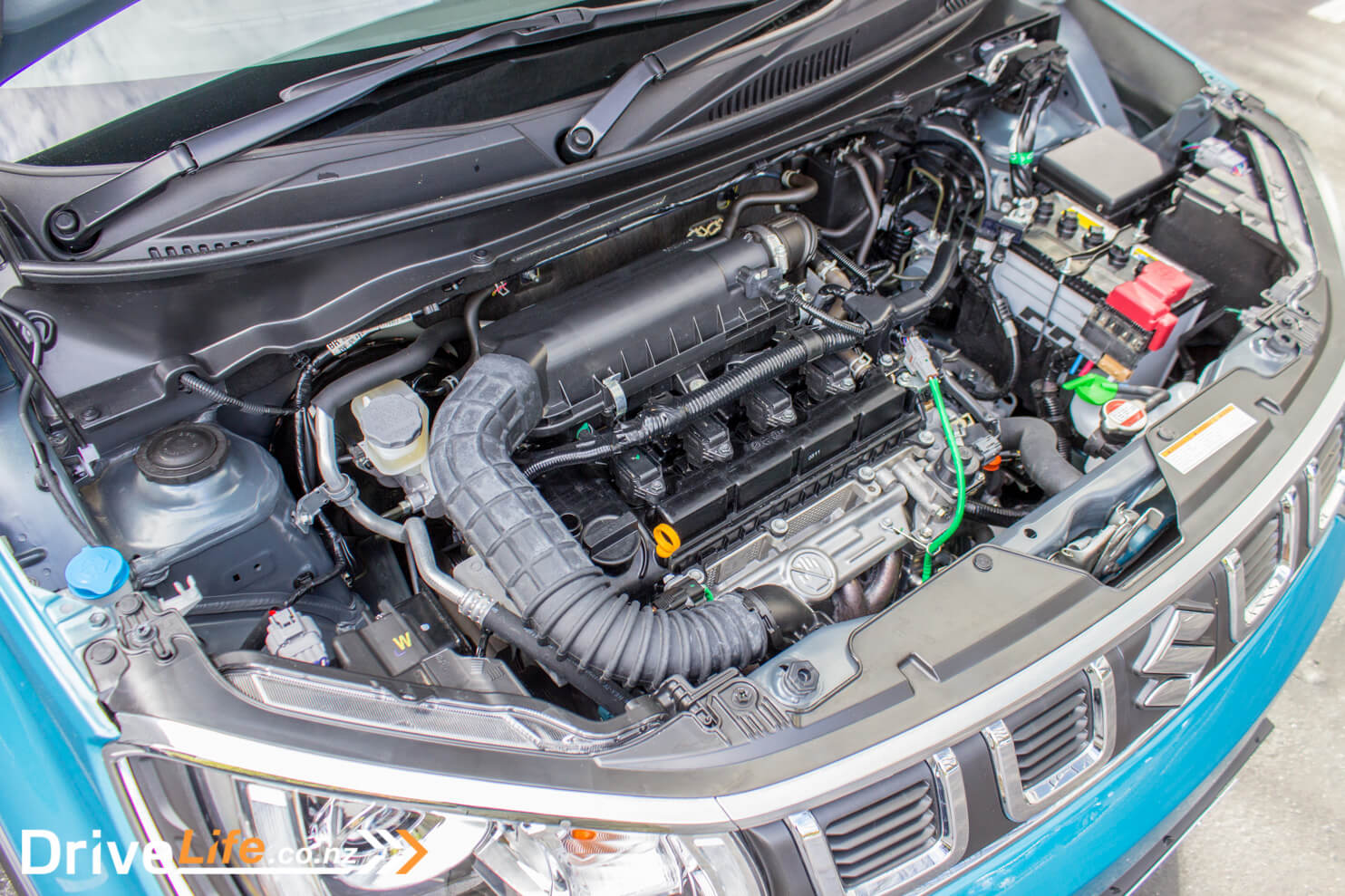
Motorway travel on the flat is a quiet affair, and much better than you’d expect in a budget car. Cross winds can play around with the car’s high stance, but overall it’s capable enough when the weather gets rough. There is some tyre and road noise, but bear in mind this is at the cheaper end of the new car market. For that reason, when looking under the bonnet you’ll see there’s no top coat paint under there. Does it matter? Not for driving the car.
The ride too is a surprise. At 905Kg, you’d think the little Ignis would bounce all over the place, but it’s actually quite smooth. Suzuki’s engineers are to be congratulated on this front, it’s an impressive feat. On the not so good front, there’s a huge blind spot on the rear quarters of the car, that swooping up line on the rear doors contributing to this. Still, it’s a very small car and that helps navigating it about city streets or on the motorway.
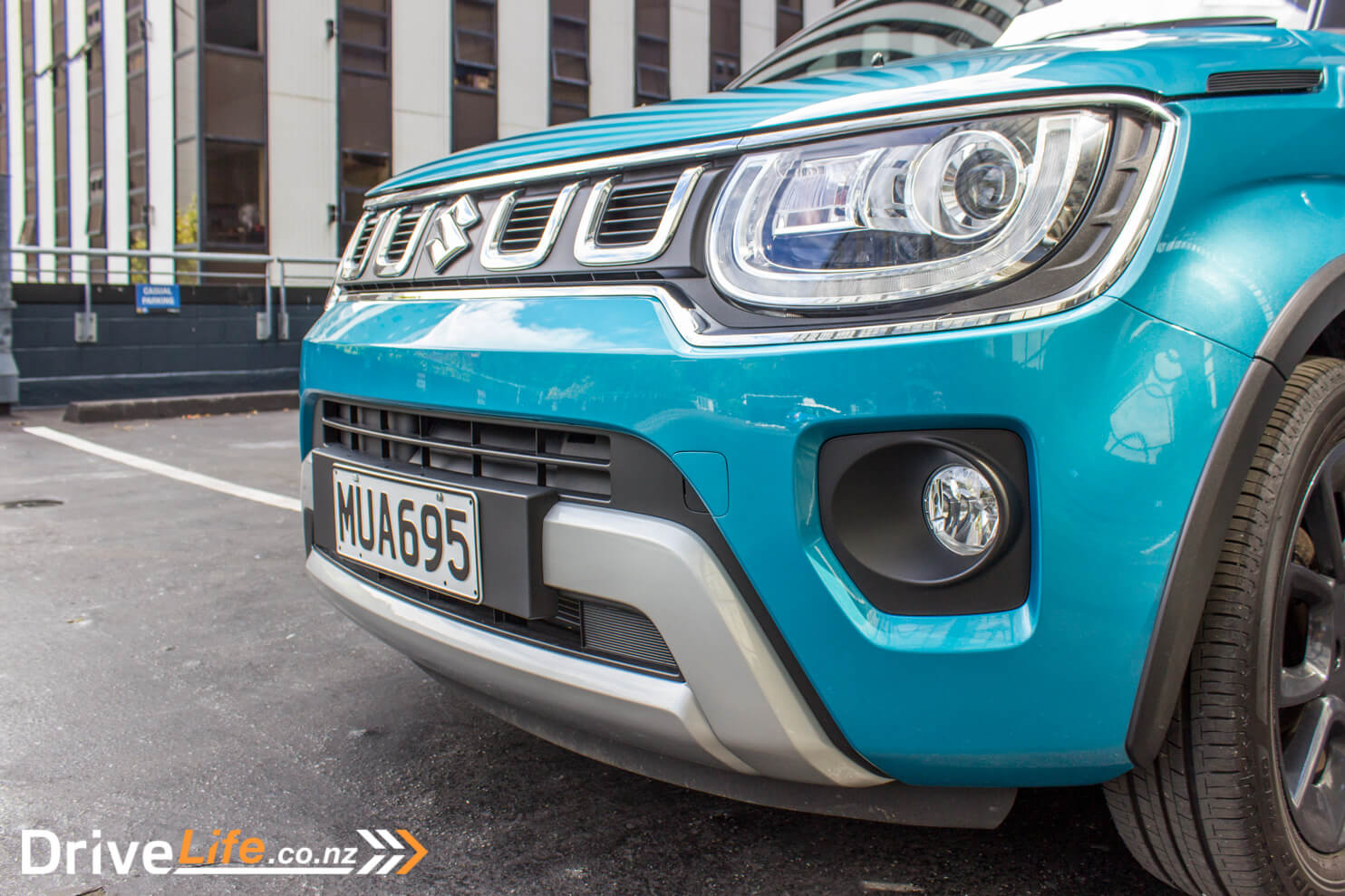
There’s no manual mode for the transmission, but you can select Low if you need some engine braking down a hill. There is a Sport mode, but it’s not really of much use, giving you slightly more performance but a lot more engine noise. It does stay on when you exit the car, so if you accidentally turn it on – it’s a button on the side of the gear lever – it’s easy to forget it’s still on when you get back in the car. There is a little ‘S’ notification on the dash to help you out.
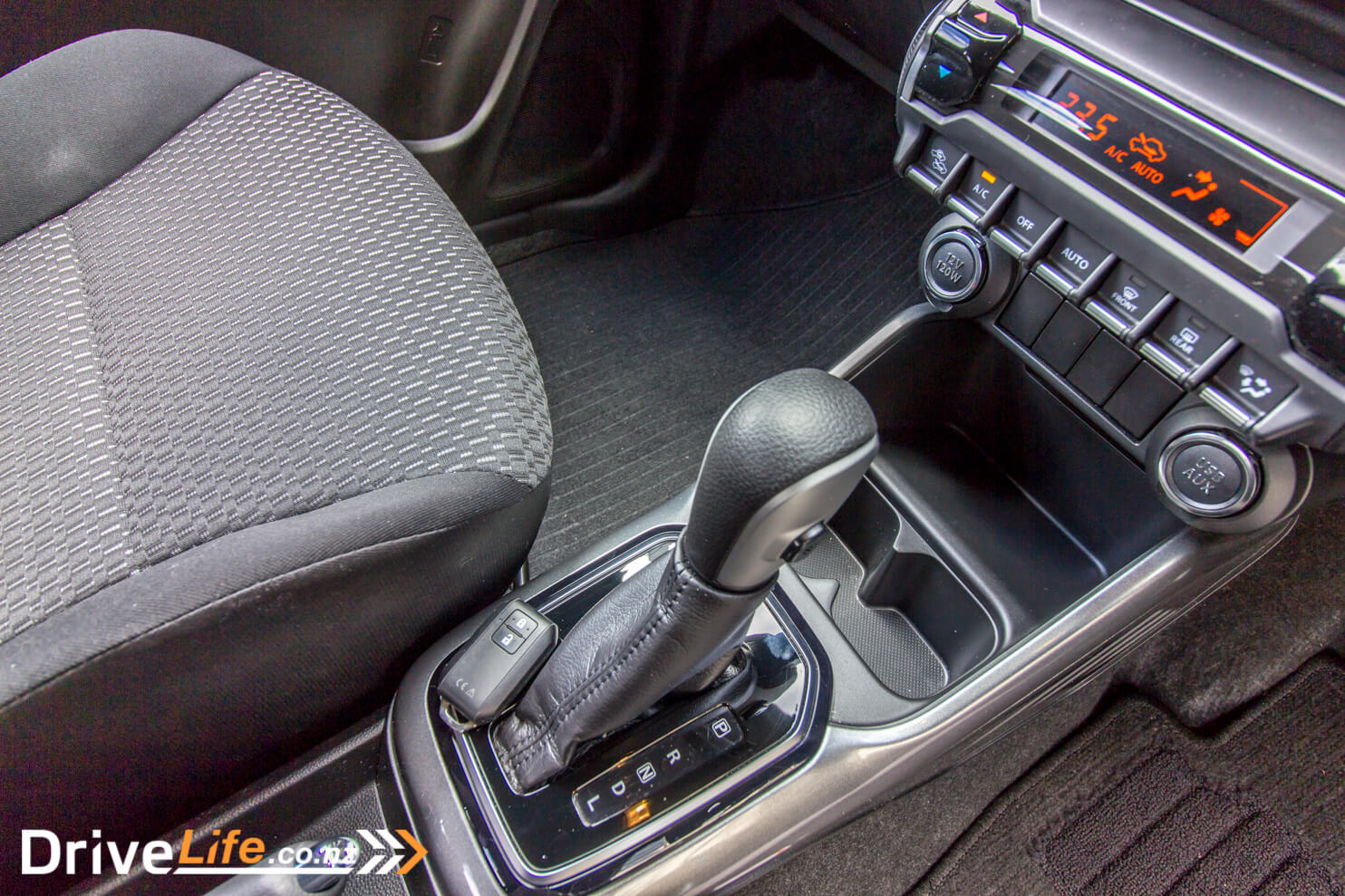
Performance is a different story when the car is loaded up. With four on board, Ngauranga Gorge was a struggle for the Ignis, with lots of noise from that engine and the CVT doing its best to manage the extra weight. That extra weight also played on the Ignis’ brakes; the brake pedal is spongy at the best of times, and with four people on board, they need a reasonable shove to make them work well. It was the first time in a while that I’d had brakes in a car that I didn’t feel confident using. They shuddered at times too, such as a panic stop on the motorway. This needs to be sorted out in the next update.
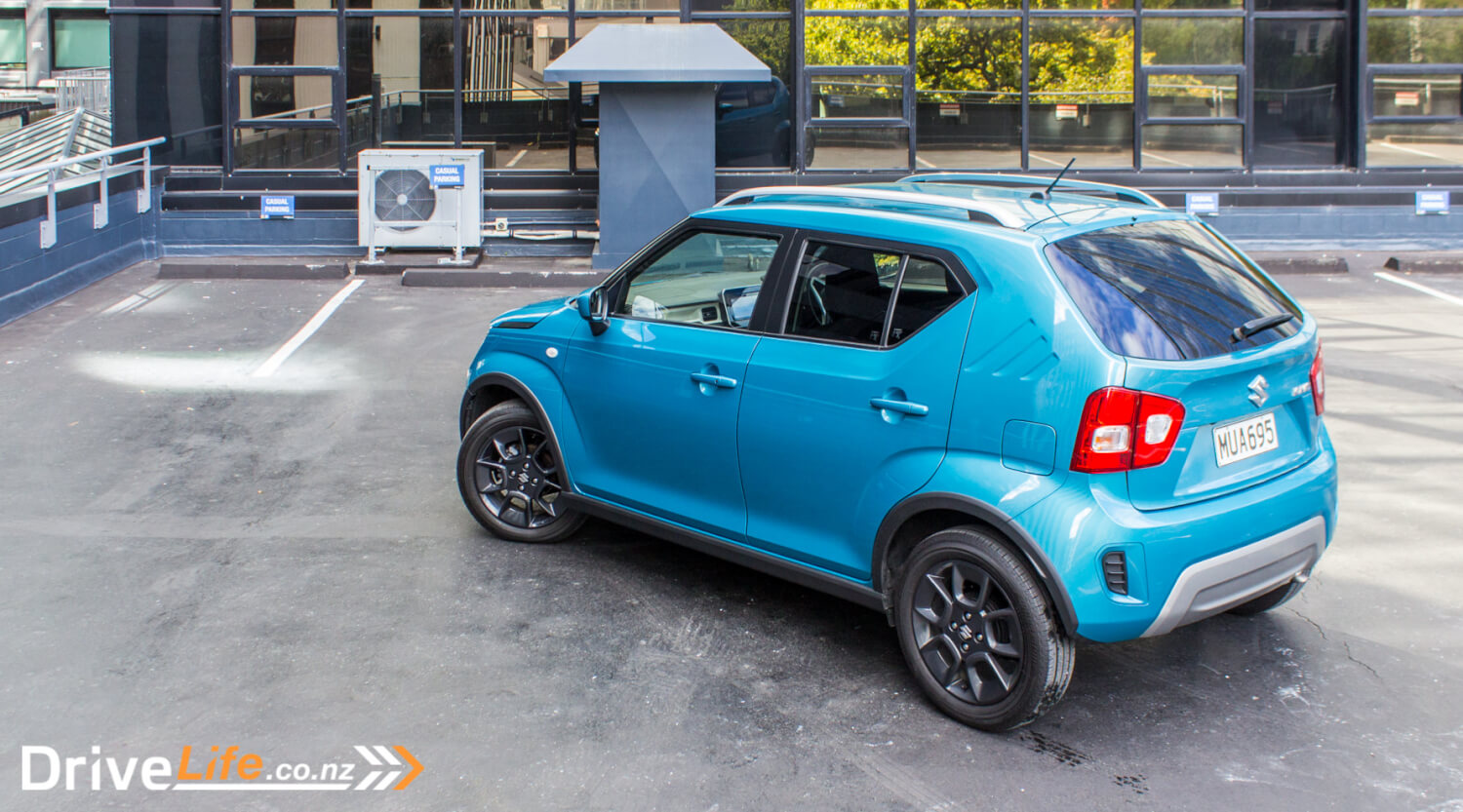
This top-spec model does have keyless entry and start, simple things which are always appreciated. The Ignis LTD also has cruise control – not adaptive, but not expected at this price – and a speed limiter. They’re operated from the steering wheel, and the controls are straightforward and simple. Actually, it’s the same for the audio controls in being simple; this is the second car in a row that for me, does audio controls just right. The Ignis’ steering wheel has the audio controls on the left, and volume up or down is a button that goes up or down, and either side of that is a left/right button for track/station change. It’s all very intuitive and easy, as it should be. The car last week ha it right too, and it was an Audi Q5, so the Ignis is in good company on this front.
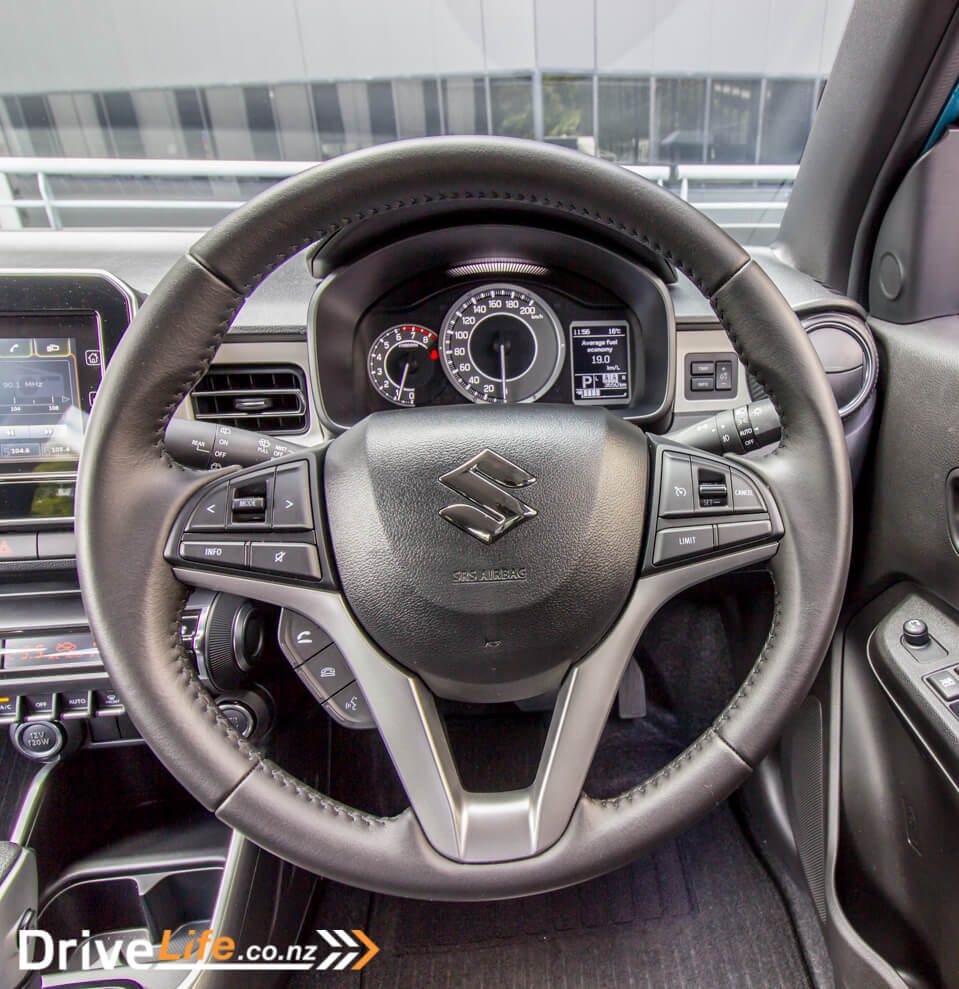
In front of the driver, the dash is nice and clear, and easy to read. The speedo does go up a very optimistic 200km/h, so there’s a lot of numbers on the speedo. Ideally, I’d like to see this dropped down to say 120km/h and give the speedo a 50km/h marking (it doesn’t have one). There’s no digital speedo either, and while I know this is a budget car, that’s something that’s desperately needed these days with our police force solely focused on that one aspect of driving.
There’s a basic trip computer on the right hand side of the dash, giving you info like time and date, range to empty, km/l instant, km/l average, total driving time, and average speed. Why is fuel consumption measured in km/litre instead of l/100km? I have no idea.
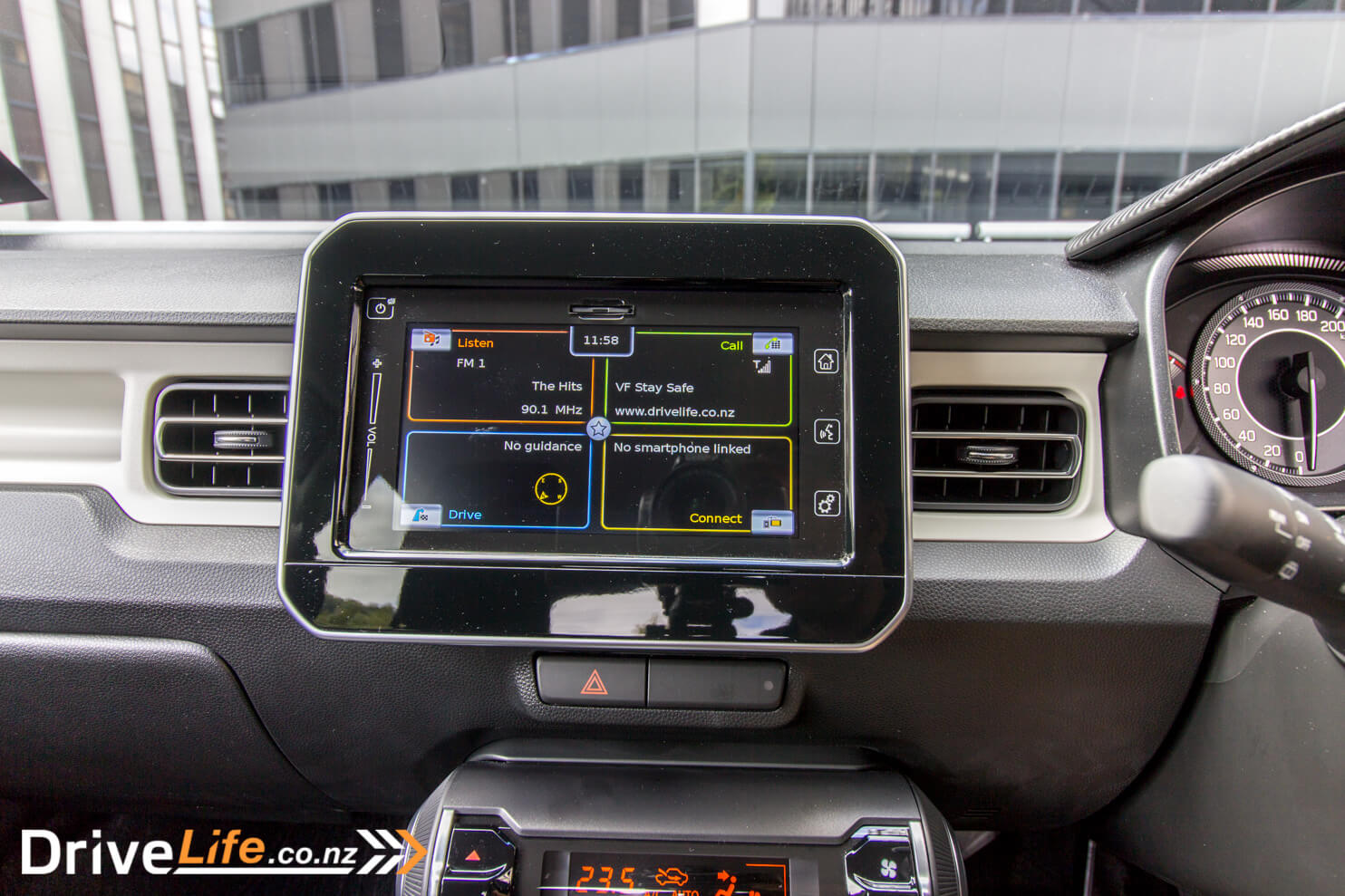

On the plus side, the front seats look very thin but are certainly comfy enough for my weight, and as you’d expect the turning circle is awesome. There’s a lot of turns lock to lock for some reason, but the Ignis can do a u-turn just about anywhere.
Audio quality is good and should appease teenage passengers, but the Ignis struggles to remember the last audio input, so will often revert to radio instead of (for example) Bluetooth. The infotainment system is relatively well-featured, with SatNav built-in and a nice, 4-panel home screen. It can be slow to switch between screens though, and like Honda used to have, there’s a sliding touch-operated volume control on the display that never really works. Please Suzuki, give us a volume knob like Honda is going back to. The screen itself is crisp and clear – far better than Toyota or Honda’s current systems – and the quality of the image of the reversing camera is excellent, too.
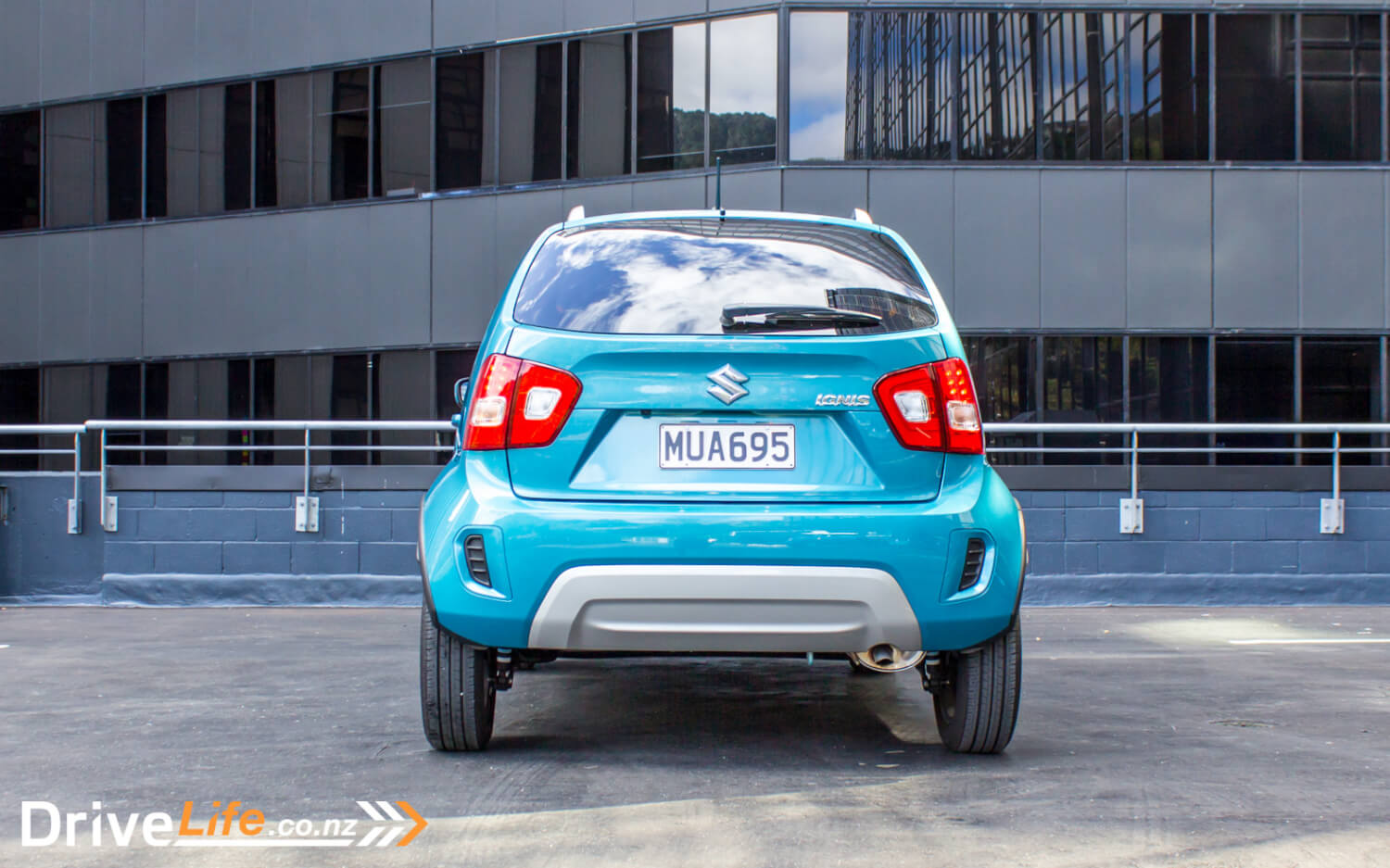
Interestingly, I found ten switch blanks which felt weird when this is the top-spec model.
Suzuki suggests the car should return 4.8L/100km. In my week with the Ignis and over 600Km of driving, I got 19.4L/100km, or 5.1L/100km. Is that good? I’d call it very good, for the size of the engine, the size of the car and its weight, and at least it’s very close to what Suzuki suggests.

What’s The Competition For The 2021 Suzuki Ignis LTD?
New Zealand’s only compact SUV? Here’s the competition as I see it for the Ignis in 2021 but this is based on small, 5-door hatchbacks.
| Brand/Model | Engine | Power/ Torque kW/Nm | Seats | Cargo capacity, litres | Fuel L/100km | Price |
| Kia Rio Limited | 1.4-litre, 4-cylinder petrol | 74/133 | 5 | 325 | 6.0 | $27,990 |
| Toyota Yaris GX | 1.5-litre, 3-cylinder petrol | 88/145 | 5 | 270 | 4.9 | $26,990 |
| Hyundai i20 Hatchback | 1.4-litre, 4-cylinder petrol | 74/134 | 5 | 301 | 6.5 | $26,990 |
| Suzuki Ignis LTD | 1.2-litre, 4-cylinder petrol | 66/120 | 4 | 264 | 4.8 | $24,990 |
| Skoda Fabia Ambition | 1.6-litre, 4-cylinder petrol | 81/155 | 5 | 330 | 5.9 | $24,990 |
| Kia Picanto X Line | 1.2-litre, 4-cylinder petrol | 62/122 | 5 | 255 | 5.8 | $23,990 |
| Mitsubishi Mirage XLS | 1.2-litre, 3-cylinder petrol | 58/102 | 5 | 235 | 5.0 | $21,990 |
| MG3 Excite | 1.5-litre, 4-cylinder petrol | 82/150 | 5 | 307 | 6.7 | $19,990 |
What’s The Pros and Cons For The 2021 Suzuki Ignis LTD?
| Pros Funky design Rear legroom, headroom Doors open so very wide Deep boot Ride quality for size/weight Audio quality at this price Audio controls Fuel economy | Cons Brakes Noisy engine under load Not great value CVT flaring |
2021 Suzuki Ignis LTD – Specifications
| Vehicle Type | Compact 5-door hatchback |
| Starting Price | $24,990 |
| Price as Tested | $24,990 |
| Engine | 1.2-litre, 4-cylinder petrol (91 octane minimum fuel) |
| Power, Torque kW/Nm | 66@6,000rpm 120@4,400rpm |
| Transmission | CVT automatic |
| Spare Wheel | Space saver |
| Kerb Weight, Kg | 905 |
| Length x Width x Height, mm | 3700x1690x1595 |
| Cargo Capacity, litres | 264/516 |
| Fuel capacity, litres | 32 |
| Fuel Efficiency, litres/100Km | Advertised Spec – combined – 4.8 Real World Test – combined – 5.1 Low Usage: 0-6 / Medium Usage 6-12 / High Usage 12+ |
| Towing Capacity Kg, unbraked/braked | NA |
| Turning circle, metres | 4.7 Small: 6-10m / Medium 10-12m / Large 12m+ |
| Warranty | 5 Years, 100,000Km 5 Years, unlimited Km Roadside Assist |
| ANCAP Safety Ratings | Not yet rated. Previous model 4 Star |


